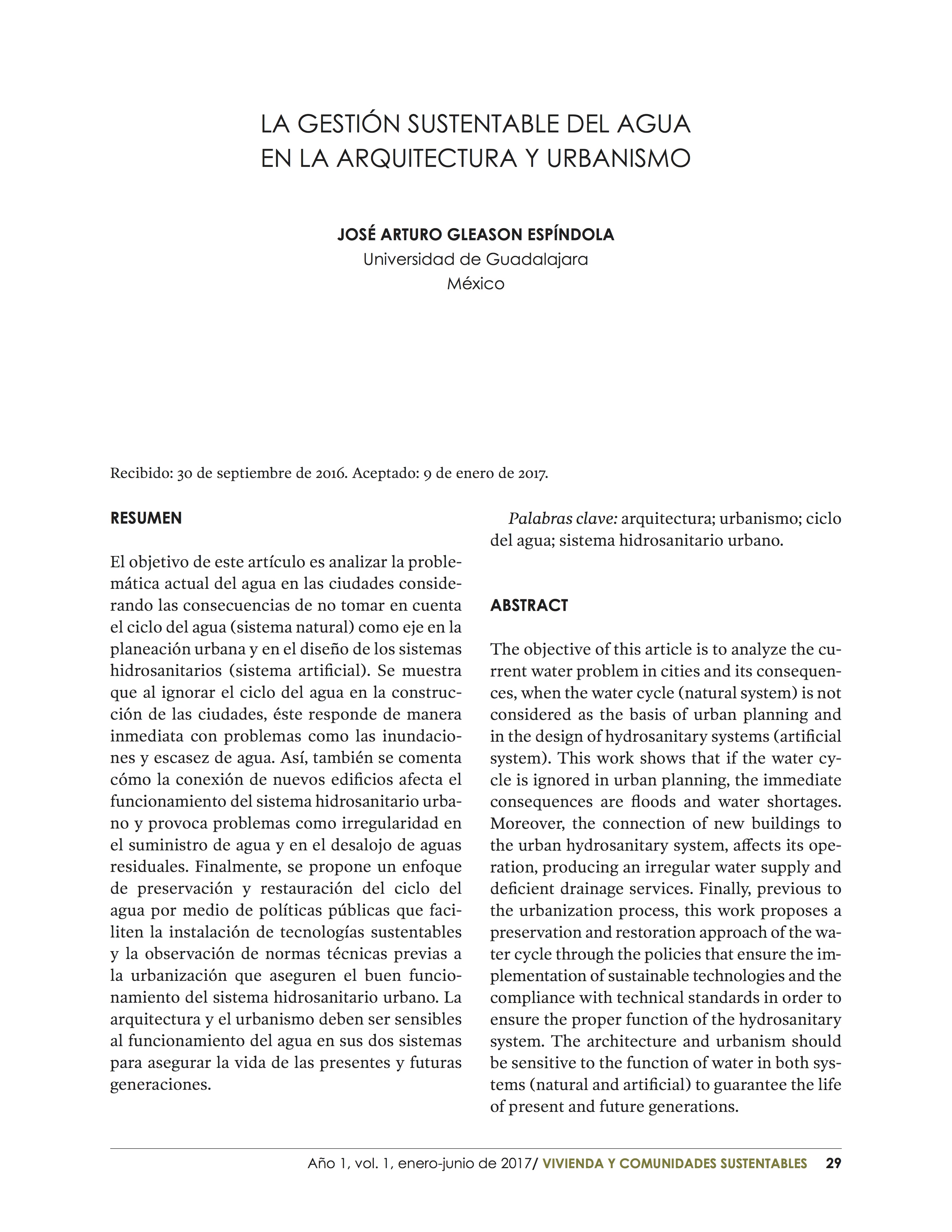Sustainable water management in architecture and urbanism
DOI:
https://doi.org/10.32870/rvcs.v0i1.3Keywords:
architecture, urbanism, water cycle, urban hydrosanitary systemAbstract
The objective of this article is to analyze the current water problem in cities and its consequences, when the water cycle (natural system) is not considered as the basis of urban planning and in the design of hydrosanitary systems (artificial system). This work shows that if the water cycle is ignored in urban planning, the immediate consequences are floods and water shortages. Moreover, the connection of new buildings to the urban hydrosanitary system, affects its operation, producing an irregular water supply and deficient drainage services. Finally, previous to the urbanization process, this work proposes a preservation and restoration approach of the water cycle through the policies that ensure the implementation of sustainable technologies and the compliance with technical standards in order to ensure the proper function of the hydrosanitary system. The architecture and urbanism should be sensitive to the function of water in both systems (natural and artificial) to guarantee the life of present and future generations.Metrics
References
Aparicio, F. (1996). Fundamentos de hidrología de Superficie. Limusa. Guadalajara.
Castillo, A. y S. Hernández (4 de noviembre de 2011). "Exige Zapopan sanciones severas por descargas de aguas negras a cielo abierto". Periódico Milenio.
CNN (Jueves 1 de julio de 2010). El huracán Alex deja más lluvia que Gilberto: Conagua. Expan- sión en alianza con CNN. Recuperado de http:// expansion.mx/nacional/2010/07/02/el-huracan-ale-deja-mas-lluvia-que-gilberto-conagua 29 de septiembre de 2016.
Gleason, J. (2014). Sistemas de agua sustentables en las ciudades. Trillas. México.
Hoban, A., y T.H.F. Wong (2006). Urban Water Cycle "WSUD resilience to Climate Change", 1st International Hydropolis Conference, Perth WA, October 2006. http://www.wsud.org/ wp-content/uploads/2012/07/WSUD-Intro- ductory-Presentation.pdf Recuperado de 29 de septiembre de 2016.
Martínez, A. (11 de abril de 2010). "Advierten de daños a acuífero Atemajac". Periódico Mural.
Ornelas, V. (2 de febrero de 2011). ¿Dónde está el agua? La verdad periodismo libre de Tlajomulco. Recuperado de http://laverdaddetlajomul- co.blogspot.mx/2011/02/donde-esta-el-agua. html el 29 de septiembre de 2016.
United States Environmental Protection Agency (1993). Guidance Manual for developing. Recuperado de https://www3.epa.gov/npdes/pubs/ owm0274.pdf 29 de septiembre de 2016. UNESCO (2015). The United Nations World Water Development Report 2015: Water for a Sustainable world. UN-Water. Paris, France.
U.S. Department of Housing and Urban Development (2003). The Practice of
Low Impact Development. Recuperado de https:// www.huduser.gov/portal/publications/pract-LowImpctDevel.pdf 29 de septiembre de 2016.
WSUD (2014). Water Sensitive urban Design in Sydney. Recuperado de http://www.wsud.org/ 29 de septiembre de 2016.

Downloads
Published
How to Cite
Issue
Section
License
Copyright (c) 2017 Vivienda y Comunidades Sustentables

This work is licensed under a Creative Commons Attribution-NonCommercial-NoDerivatives 4.0 International License.
The authors who publish in this journal accept the following conditions:
In accordance with the copyright legislation, Sustainable Housing and Communities recognizes and respects the moral right of the authors, as well as the ownership of the patrimonial right, which will be transferred to the University of Guadalajara for its dissemination in open access. Sustainable Housing and Communities does not charge authors for submitting and processing articles for publication. Authors may make other independent and additional contractual agreements for the non-exclusive distribution of the version of the article published in Sustainable Housing and Communities (for example, include it in an institutional repository or publish it in a book) as long as they clearly indicate that the work is published for the first time in Sustainable Housing and Communities.





